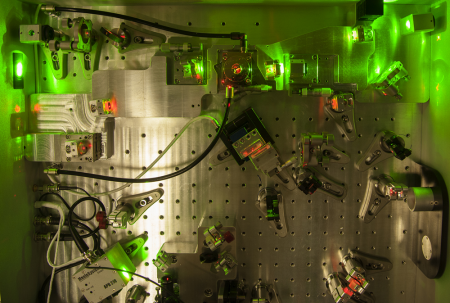The enhancement of the electric field is important to measure since in the course of research and development it is necessary to know how efficient various nanoparticles or nanostructured surfaces are in the given application. The unique feature of the new method worked out in the project is its ability to measure field enhancement directly, whereas previous methods are either destructive they destroy the sample while measuring – or provide indirect information only. The findings were published in Nano Letters, the leading journal of nanoscience, with one of the highest impact factor of 13 in this area.
“Field enhancement is caused by the fact – explains Péter Dombi, head of the research group – that the electric field of the light illuminating the nanoparticles of the metal makes the free electrons in the metal move. Due to the movement of the electric charge, in the case of a nanoparticle of sufficient size, resonance will evolve, resulting in the electric field of light “concentrating” in the proximity of the nanoparticles. All this occurs in a domain significantly smaller than the wavelength of light; the electric field lines are then densely located close to the metal particle, and due to this density – locally, on a nanometric scale – field intensity increases. Thus, field enhancement and the nanometric localisation of the electric field are closely interrelated.”
How was this possible to measure? The nanoparticle is illuminated by very short laser pulses lasting for some femtoseconds, i.e. one millionth of one billionth of a second. This also makes electrons leave the sample, and the size of field enhancement is arrived at by measuring the energy of these (the distribution of the kinetic energy of electrons). As the research team is already able to determine field enhancement experimentally as well, those working on practical applications may receive direct feedback based on the results of measurements of the samples sent to the research group, which will enable them feedback about the applied nanostructures depending on this “diagnostics”, if need be.
 |
| Part of the laser system used to measure the field enhancement of nanoparticles |
The laboratory and the instruments enabling these measurements were developed by the Lendület (Momentum) Research Group set up in 2014, relying on different sources of funding including the domestic NRDI Fund (formerly known as OTKA). Experiments leading up to the world class scientific result were carried out exclusively in Budapest, at the Wigner Research Centre for Physics of the Hungarian Academy of Sciences; the foreign co-authors of the article provided the samples required for the purpose of the experiments.
While experimenting in the context of the research project, several opportunities for further research took shape, which might open up new perspectives in terms of the practical applications of the findings. For example, a more accurate calibration of the measurement of field enhancement may be suitable for the purpose of determining different material constants of nanoparticles including the index of refraction. This is important as the properties of nanosystems may differ from the properties of macroscopic systems. Another possibility for researchers is to optimise nanostructures themselves for their own new applications, with the novel experimental arrangement at hand.
Previous funded project of the researcher related to this topic:
2006–2010: Investigation of femto- and attosecond light-solid interactions with controlled-waveform laser pulses. – F 60256 (HUF 10.002 million)
Funded project: K 109257
Time-resolved investigation of functional molecules and nanosystems
Duration: February 2014 – January 2018
Project leader: Péter Dombi, senior research fellow, Wigner Research Centre for Physics
Amount of funding: HUF 29.724 million






